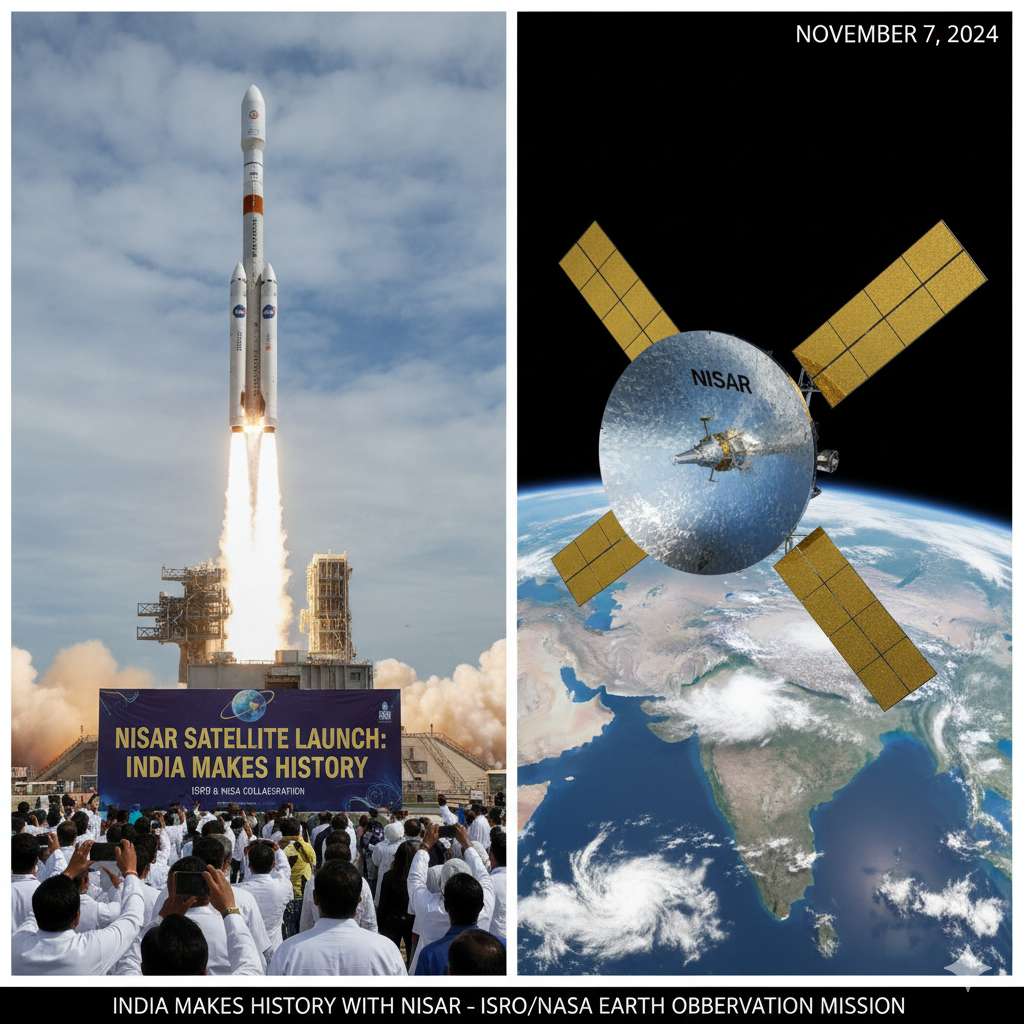Once again, India’s space program is poised to make history. Furthermore, the Indian Space Research Organisation (ISRO) has just announced that the revolutionary NISAR satellite will become operational on November 7, thus marking a watershed moment in Earth observation technology. Moreover, ISRO Chief S. Somanath dropped another bombshell: India’s first uncrewed Gaganyaan mission is set for January 2026, bringing the nation one step closer to joining the elite club of countries with human spaceflight capabilities.
These aren’t just routine satellite launches. Rather, they represent India’s bold leap into advanced space technology that will benefit humanity for decades to come. Consequently, scientists, policymakers, and space enthusiasts worldwide are watching with keen interest as India continues its remarkable journey among the stars.
What Makes NISAR Satellite a Game-Changer?
The Powerhouse Partnership
NISAR stands for NASA-ISRO Synthetic Aperture Radar, and the name tells you everything about this groundbreaking collaboration. When two space giants join forces, extraordinary things happen. This mission combines:
- NASA’s cutting-edge L-band radar technology
- ISRO’s advanced S-band radar systems
- Dual-frequency capabilities for comprehensive Earth monitoring
- The largest deployable antenna ever launched—a massive 12-meter reflector
Furthermore, this partnership showcases how international cooperation can achieve what single nations cannot. The collaboration pools resources, expertise, and innovation to create something truly revolutionary.
Revolutionary Technology at Work
NISAR isn’t your average satellite. Instead, it’s packed with technology that seems straight out of science fiction:
Key Capabilities:
- Sees through clouds, darkness, and dense vegetation
- Detects surface movements as tiny as a few centimeters
- Covers vast areas while maintaining incredible detail
- Revisits the same location every 12 days for consistent monitoring
- Operates 24/7 regardless of weather conditions
Additionally, the dual-radar system works like having two expert observers examining Earth simultaneously. The L-band radar penetrates deep into forests and soil, while the S-band radar captures surface-level details with stunning precision. Together, they create a complete picture that scientists have never had access to before.
Why Should You Care About NISAR Satellite?

Real-World Impact on Everyday Lives
This isn’t just about collecting data for research papers. Rather, NISAR will directly affect millions of lives through practical applications:
Climate Action:
- Tracks melting ice sheets and glaciers in real-time
- Monitors permafrost thawing releasing greenhouse gases
- Provides accurate data for climate predictions
- Helps coastal communities prepare for sea-level rise
Disaster Prevention:
- Detects earthquake damage instantly for faster relief operations
- Identifies ground deformation signaling volcanic activity
- Maps flood-affected areas through clouds and storms
- Enables early warnings that save lives
Agricultural Revolution:
- Monitors soil moisture for optimized irrigation
- Detects crop stress before visible to human eyes
- Estimates crop yields with unprecedented accuracy
- Helps farmers make data-driven decisions
Environmental Protection:
- Catches illegal logging activities in real-time
- Tracks deforestation and forest regeneration
- Monitors wetland health and biodiversity
- Protects coastal mangroves and ecosystems
Consequently, NISAR Satellite transforms abstract space technology into tangible benefits touching agriculture, disaster management, climate science, and conservation.
READ MORE:- Cyclone Montha Devastates Eastern India With 110 kmph Winds
The Road to November 7: A Decade-Long Journey
Overcoming Challenges Together
Building NISAR wasn’t easy. The project faced numerous hurdles over nearly ten years of development. However, engineers from NASA and ISRO persevered through:
- Complex integration of systems from two different space programs
- Harmonizing technical standards across continents
- COVID-19 pandemic delays and restrictions
- Rigorous testing requirements for mission success
Nevertheless, the collaborative spirit between American and Indian teams kept the mission moving forward. Engineers adapted, innovated, and ultimately created a masterpiece of space technology.
Rigorous Testing Ensures Success
Before declaring NISAR Satellite operational, teams conducted exhaustive testing:
Testing Milestones:
- Thermal vacuum tests simulating harsh space conditions
- Vibration tests replicating intense launch forces
- Radar calibration ensuring pinpoint accuracy
- Operational procedure rehearsals covering every scenario
Moreover, this meticulous preparation guarantees that when NISAR begins operations on November 7, it will perform flawlessly from day one.
Gaganyaan: India’s Human Spaceflight Dream Takes Shape
January 2026: The Countdown Begins
While NISAR captures headlines, the Gaganyaan announcement is equally thrilling. India’s first uncrewed human spaceflight mission scheduled for January 2026 represents years of dedicated preparation. This mission will:
- Test all critical life support systems
- Validate spacecraft performance in actual spaceflight conditions
- Carry a humanoid robot simulating astronaut activities
- Provide crucial data for the eventual crewed mission
Subsequently, successful completion of this test flight clears the path for Indian astronauts to reach space, making India only the fourth nation to achieve independent human spaceflight.
What’s at Stake?
National Pride and Global Recognition:
- Demonstrates India’s advanced technological capabilities
- Establishes India as a major space power
- Inspires millions of young Indians toward STEM careers
- Opens doors for international collaboration opportunities
Furthermore, the Gaganyaan program drives innovation across multiple sectors. Technologies developed for human spaceflight often find applications in medicine, materials science, and everyday products.

Preparing for the Historic Mission: NISAR Satellite
ISRO has left nothing to chance. Preparations include:
- Development of human-rated launch vehicles with enhanced safety
- Advanced life support systems maintaining habitable environments
- Rigorous astronaut training programs in India and Russia
- Extensive emergency procedure rehearsals
- Multiple ground tests validating every system
Therefore, when the uncrewed mission launches in January 2026, it will represent the culmination of meticulous planning and preparation.
The Bigger Picture: India’s Space Ambitions
Beyond Earth’s Orbit:- NISAR Satellite
NISAR and Gaganyaan are just the beginning. ISRO has ambitious plans extending far into the solar system:
Future Missions Include:
- Detailed lunar exploration programs
- Advanced Mars missions
- Venus atmospheric studies
- Plans for an Indian space station
Additionally, each successful mission builds capabilities and confidence for increasingly ambitious undertakings. India’s space program continues evolving from following others to leading exploration efforts.
Economic Growth and Strategic Advantages
India’s expanding space capabilities generate substantial economic benefits:
- Growing commercial space sector creating high-skilled jobs
- International customers seeking India’s cost-effective launch services
- Private companies gaining expertise through ISRO partnerships
- Revenue generation funding future technological development
Moreover, indigenous space capabilities provide strategic advantages in infrastructure planning, disaster response, and resource management. Countries with advanced space programs enjoy greater influence in global technology discussions.
Inspiring the Next Generation
Making Space Accessible to All
ISRO actively engages with students and educators through:
- Educational outreach programs bringing space to classrooms
- Resources and expertise enhancing science education
- Live mission streams attracting millions of viewers
- Social media engagement creating enthusiast communities
Consequently, more young people develop passion for science and technology, building tomorrow’s workforce for continued innovation.
Global Media Attention
Remarkably, the upcoming NISAR operational declaration and Gaganyaan updates have captured worldwide attention. Meanwhile, news outlets from every continent cover these developments, highlighting India’s remarkable space achievements. Therefore, this coverage raises awareness about space science’s practical applications in everyday life.
Furthermore, international recognition reinforces India’s position as a technology leader and inspires other developing nations to invest in space programs.
Looking Ahead: What Comes Next?
November 7 and Beyond: NISAR Satellite
When NISAR becomes operational on November 7, it will immediately begin collecting invaluable Earth observation data. Scientists worldwide eagerly await access to this information, which will accelerate discoveries across numerous disciplines.
Meanwhile, preparations for the January 2026 Gaganyaan mission continue intensifying. Every test, every simulation, every training session brings India closer to its human spaceflight dream.
A New Era of Space Exploration: NISAR Satellite
These missions represent more than technological achievements. Rather, they symbolize India’s commitment to using space technology for human benefit. NISAR will help address climate change, protect ecosystems, and save lives during disasters. Gaganyaan will inspire generations and establish India among spacefaring nations.
Additionally, the success of international collaboration on NISAR demonstrates that humanity can achieve remarkable things when nations work together toward common goals.
In Conclusion
Notably, the announcement of NISAR’s November 7 operational date and Gaganyaan’s January 2026 uncrewed mission marks pivotal moments in India’s space journey. These aren’t just missions—they’re investments in humanity’s future, addressing global challenges while pushing technological boundaries.
NISAR will revolutionize Earth observation, providing unprecedented insights into our planet’s dynamic systems. Gaganyaan will fulfill India’s human spaceflight aspirations while demonstrating advanced technological capabilities. Together, they showcase India’s emergence as a major space power contributing meaningfully to global exploration efforts.
As we count down to these historic milestones, excitement steadily builds across the scientific community and beyond. In addition, the data from NISAR and experiences from Gaganyaan will shape future missions and expand humanity’s collective knowledge. More importantly, these achievements represent India’s contribution to understanding and exploring our universe. Indeed, the benefits extend far beyond national borders.
The future of space exploration looks brighter than ever, and India stands at the forefront of this exciting journey.












Hello! I sent a request, but have not yet received a response. Please contact me via WhatsApp.
wa.me/+79173031189